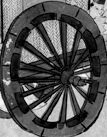Machine Generated Data
Tags
Color Analysis
Feature analysis
Categories
Imagga
| paintings art | 92.4% | |
| text visuals | 6.6% | |
Captions
Azure OpenAI
Created on 2024-12-04
This image appears to be a black and white photograph of a traditional East Asian painting or illustration. The scene depicted in the artwork portrays multiple figures involved in some form of activity. There are at least two wheeled carts or chariots present in the scene. People are shown around these carts in various stances and it looks like some of them may be engaged in a kind of procession or an event. The figures are dressed in the attire that suggests it might be a historical or courtly scene, possibly related to nobility or royalty, given the formality of the setting and their clothing. Some of the figures are seated in poses that suggest they may be of higher status. The style of the artwork, including the depiction of the individuals, their garments, and the carts suggest that it may come from a classical period in the region's art history, reminiscent of scenes from historical texts or scrolls. The absence of color in the photograph makes it challenging to discern more specific details, but the composition and style are indicative of traditional and historical Oriental artwork. Below the artwork, there is a textual label that reads, "Genji Kuruma... 1942.172," which likely refers to the title or subject of the painting and an accession number or catalogue reference associated with its collection or exhibition. "Genji" could be in reference to "The Tale of Genji," which is a classic work of Japanese literature from the early 11th century, known for its detailed depiction of courtly life. "Kuruma" translates to "carriage" or "wheel," which connects to the visible carriages in the scene.
Anthropic Claude
Created on 2024-11-27
The image appears to be a black and white photograph or drawing depicting a busy, lively scene. The central focus is a large wooden cart or wagon with a large wheel, surrounded by numerous figures engaged in various activities. The background is filled with intricate details and patterns, suggesting a complex and dynamic scene. The artwork appears to be from a historical or cultural context, as indicated by the title "Genji/Kuruma... 1942.172". The style and subject matter suggest this may be a traditional Japanese artwork or illustration.
Meta Llama
Created on 2024-12-02
The image is a black-and-white photograph of a scroll painting, likely from the 1940s, featuring a scene with multiple people and objects. * The scroll painting is rectangular in shape and appears to be made of paper or silk. * It has a light-colored background with darker shading and lines that suggest movement and action. * The painting depicts a scene with many people, some of whom are riding horses or carts, while others are walking or standing. * There are also several objects visible in the painting, including what appears to be a building or structure in the background. * The overall style of the painting suggests it may be a traditional Japanese art piece, possibly from the Edo period (1603-1868) or earlier. * The painting is mounted on a white wall, with a small label or plaque below it that reads "Genji/Kuruma... 1942.172..." in black text. * The label suggests that the painting may be part of a collection or exhibit, and the date "1942.172" may indicate when it was acquired or added to the collection. * The painting is surrounded by a white border, which helps to frame the image and draw attention to the central subject. * Overall, the image provides a glimpse into the artistic style and techniques of traditional Japanese art, as well as the cultural and historical context in which it was created.













